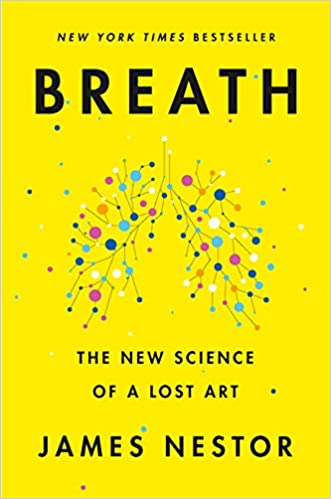The Surprising Connection Between Dental Health and Your Fitness Journey
Dental-Fitness Connection
Today, we’re going to dive into a topic that’s perhaps a bit surprising to many: the impact of dental health on fitness routines and posture.
In this article, we’ll explore how our dental and oral health intertwines with our physical fitness. From childhood malocclusion to its impact on spinal alignment, we explore how dental health influences overall well-being. We also uncover the reciprocal connection between physical activity and gum health, highlighting the multifaceted interplay that goes beyond fitness. It’s a journey through the lesser-known aspects of dental health that can have a significant impact on our daily lives.
How the Alignment of our Teeth Impacts Posture and Exercise
Misalignment of the teeth and jaw, otherwise known as malocclusion, can have an impact on posture and body alignment, which increases chances of gym injuries. Let’s take a deeper dive.
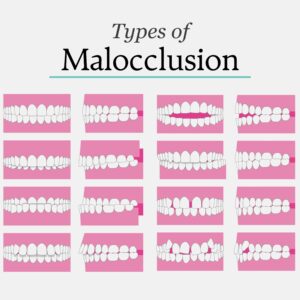
Malocclusion typically begins during infancy or childhood, and is often caused by abnormal functions such as incorrect oral posture, tethered oral ties, mouth breathing, tongue thrust swallowing, and abnormal tongue function. As children grow, their jaw and facial structures are affected, leading to high and narrow palates, crowded teeth, and malocclusion.
While there are many factors that affect spinal and body posture, one of the most overlooked is the mouth. There are several studies that show occlusion (the way the teeth meet) strongly influences muscle tone necessary in keeping proper posture.
Around the age of 6-7, when the first molar teeth erupt, they contribute to giving stability to the cervical spine (the neck region). Ideally, as the lower jaw comes up to meet the upper jaw, the paired muscles work evenly because the teeth are in even contact on both sides, supporting proper muscle tone and postural alignment.
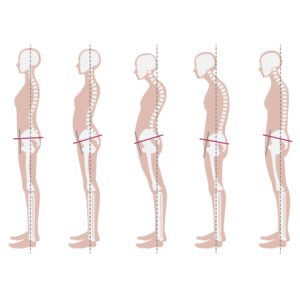
However, any imbalance in how the teeth contact will distort the connections and muscles all the way down the spine – like a domino effect. This impacts the temporomandibular joint (TMJ), which connects the lower jaw to the skull. When the jaw joints and muscles in the head and neck are out of balance, it creates dysfunction and can lead to pain, crooked teeth, head and neck disorders, sleep disorders, and even impaired athletic performance.
To paint a better picture of how this impacts body posture:
The skull rests on the atlas, which is the first cervical vertebra of the spine (C1) and is located in the neck. It supports the skull, facilitates neck movement and protects the spinal cord. All vertebrae in the spine have 3 points of contact, and the third point of contact in the C1 vertebrae is our teeth! Imagine the 3 points of contact like a 3-legged chair. If the teeth are misaligned, this creates imbalance, and will have a domino effect impact on the rest of the spine.

This was demonstrated in rats by D’Attilio et. al. in the Journal of Craniomandibular Practice (April 2005). A plastic filling placed on the molar of a rat created a distortion in the bite called a scoliosis. It was corrected by the removal of the filling. This was further demonstrated in humans by Dr. Al Fonder, where he used a filling to ‘balance’ the bite.
When exercising or playing sports, proper posture is heavily emphasized to prevent injury. However, encouraging correct form becomes challenging when dealing with misaligned posture, and could potentially lead to muscle strain and other injuries. If you find certain exercises challenging, or are prone to muscle strain and injury, an assessment from a functional or airway dentist can help identify underlying issues and provide tailored treatment to enhance your performance and reduce risk of injury.
The Connection between Exercise and Gum Disease
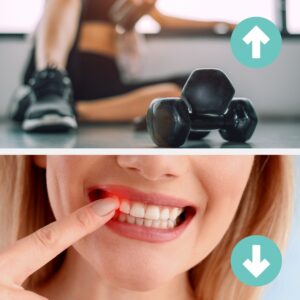
We discussed how our oral health impacts our physical activity, so now let’s look at the flip side. Regular exercise is a cornerstone of a healthy lifestyle, but did you know its impacts extend far beyond just physical fitness and also play a role in oral health? Emerging studies suggest a connection between regular physical activity and a reduced risk of periodontitis and gum disease.
First let’s talk about gum disease, also referred to as periodontitis, which is inflammation and infection of the gums and bone that surround and support the teeth. Early stages of gum disease is known as gingivitis, where the gums can become swollen, red, and may bleed from time to time. If not treated properly, gingivitis can worsen, leading to periodontitis, where the gums start to pull away from the tooth, teeth may loosen or fall out, and we start to see a decrease in bone density.
According to the CDC, about 47% of adults aged 30 and older have some form of periodontal disease, increasing with age where about 70% of adults over the age of 65 are affected. This is incredibly important when we consider the intricate connections within the human body. There are studies that indicate that having gum disease may increase the risk of various health conditions like cardiovascular disease, rheumatoid arthritis, diabetes, Alzheimer’s, inflammatory bowel disease and more.

Maintaining optimal gum health and preventing the progression of mild periodontitis involves various strategies. These can include practicing diligent oral hygiene, scheduling regular dental visits, incorporating tongue scraping into your routine, and eating nutrient-dense whole foods. Additionally, emerging research suggests that regular physical activity may play a role in both treating and preventing gum disease.
A recent meta-analysis published in 2023 found that higher levels of physical activity were associated with a lower prevalence of periodontal disease and vice-versa. It also found that obesity has been associated with periodontitis through shared pathways of chronic low-grade inflammation and immune cell dysregulation. Several studies show that low to moderate intensity exercise reduces inflammatory biomarkers, which are linked to gum disease, along with several other diseases and health conditions. So not only does regular physical activity help prevent periodontitis and gum disease, it helps reduce inflammation in the body and prevent various kinds of potential health concerns.
The Takeaway
Overall, the intricate connections between oral health, posture, exercise and physical activity underscore the importance of a well-rounded, holistic approach to well-being. Malocclusion, often rooted in childhood, can set off a chain reaction impacting the TMJ and spinal alignment, which emphasizes the critical role of dental alignment in maintaining proper posture, especially so when exercising. Furthermore, the relationship between physical activity and gum health adds another layer to this interconnected web. Regular exercise not only reduces the risk of periodontal diseases but also addresses inflammation, a common factor in various health conditions.
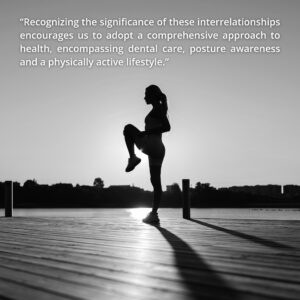
Recognizing the significance of these interrelationships encourages us to adopt a comprehensive approach to health, encompassing dental care, posture awareness and a physically active lifestyle. By understanding and addressing the connections between seemingly different aspects of our health and body, we can strive towards a well-rounded and resilient state of well-being where we can feel our best. Remember, every small adjustment and effort can have a ripple effect, promoting a healthier and more vibrant life.
References
https://www.ncbi.nlm.nih.gov/pmc/articles/PMC6438044/
https://www.cdc.gov/oralhealth/conditions/periodontal-disease.html
https://www.ugr.es/~alberodr/curriculum/articulos/116.pdf
https://www.ncbi.nlm.nih.gov/pmc/articles/PMC10679732/#B26
Recommended Reading
If you are interested in learning more about the science of breath and how it affects your optimal health, see below.
Breath: The New Science of a Lost Art by James Nestor is A New York Times Bestseller, A Washington Post Notable Nonfiction Book of 2020, and named a Best Book of 2020 by NPR.
This is an excellent book that Dr. Johal recommends to patients and colleagues alike on a regular basis. The author, James Nestor, travels the world while researching for the book to try different techniques on himself. He has a gift of sharing what he learns with us in an easy to read and engaging way.
The key takeaway from this book is that there are many qualities to breathing that are vital to our health.
For example, he discusses many modern health issues such as asthma, anxiety, ADHD, which can be reduced or even reversed simply by changing the way we inhale and exhale. Nestor explains the evolutionary changes in our facial structure over the past several hundred years and how they contribute to our breathing and health problems. He talks about the adverse affects of mouth breathing (which 80% of us do) and how, in an experiment, his health rebounded when he trained himself to only breath through his nose.
In this book you will also find a lot of breathing exercises that you can implement right away. He explains how to do them and why they are effective. If you’re stressed, if you snore, if you have sleep apnea, if you have other respiratory issues, or if you know someone who suffers from these ailments, then this book might may be helpful in offering new insights to your health situation. It’s both informative, easy and fun to read. Simply put, it offers easy ways for you to feel better and healthier through your breath.
Family Dental Centre Home Page: www.familydentalguelph.com



